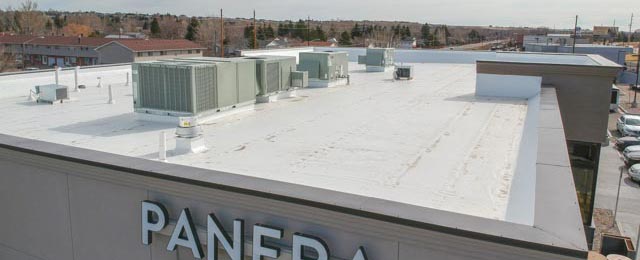PVC stands for polyvinyl chloride. It is a type of plastic that’s well known for it’s affordability and durability. PVC roofing is also known as vinyl roofing membrane. It is made from two layers of roofing material with a layer of polyester in between to act as a reinforcement. PVC is used in a wide variety of products including home and commercial roofs. If you’re ready for a new PVC roof, contact us.

Contact us today for a free PVC roof estimate or inspection.
Why Choose PVC?
PVC roofing is often used for restaurants because it is resistant to animal fats. How does animal fat and grease get on your roof? Restaurant kitchens, and most household kitchens, have an exhaust system that vents to the roof. Fat and grease particles inevitably get airborne and are exhausted through this ventilation system. Those fat and grease droplets build-up on your roof. That’s why, if you have a restaurant, you should have a PVC roof. Because PVC has been around since the 1970s, it is a proven product. Along with TPO roofing, it also has an active recycling program. A PVC roof holds-up very well to even the harshest weather, including hail. It is cost-effective, very durable, fire-resistant, reflective, reliable, strong, lightweight, and long-lasting.
PVC has an average lifespan of at least 25 years, if installed correctly and regularly inspected and maintained.
On average, the total cost to install a PVC roof is between $4 and $8 per square foot. By comparison, a TPO roof costs between $3.5 and $6.00 per square foot. A EPDM roof costs around $5.50 per square foot.
Learn more about the differences between the commercial roofing systems in our Commercial Roofing Guide.
How is a PVC Roof Installed?
PVC roofing is installed one of two ways: glued or welded. In each method, attaching the plastic sheets to the insulation board helps prevent uplift. 1. Glued: A lesser used method is to glue the plastic sheets together. The edge of each plastic sheet are attached to a ridged insulation board using glue. 2. Welded: The most common method of installing PVC roofing is what’s called “hot air welding”. This is where the edge of each 6′ to 18′ wide sheet is secured through ridged insulation onto a structural deck, and the next sheet roll is laid down over the fasteners. The overlapping sheets are then heat-welded with hot air to create a one continuous sheet membrane. Welding with hot air creates a permanent bond between the PVC roofing sheets, essentially creating one large roofing membrane for your building which can be walked on. The sheets can often be re-welded, with the exception of CSPE (chlorosulfonated polyethylene). PVC roofing works well on both large buildings, such as big box stores, and small roofs since it’s easy to weld with hot air.
Summary:
- often used for restaurants
- been around since the 1970s
- average lifespan of 25 years
- holds-up to harsh weather
- recyclable
- cost $4-$8/sf
